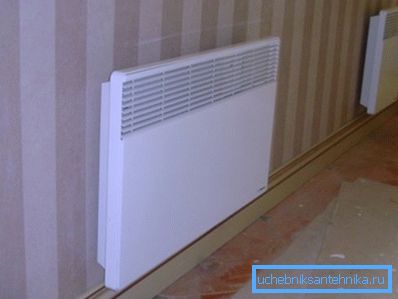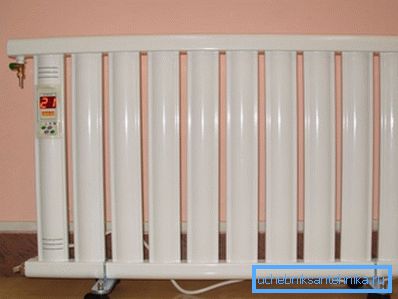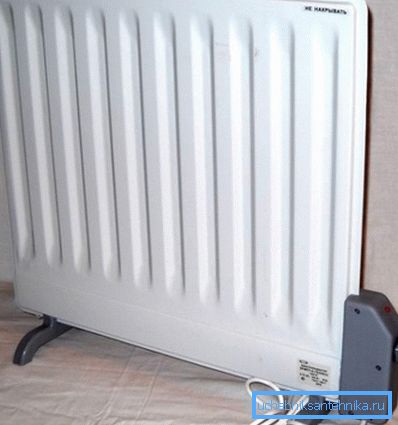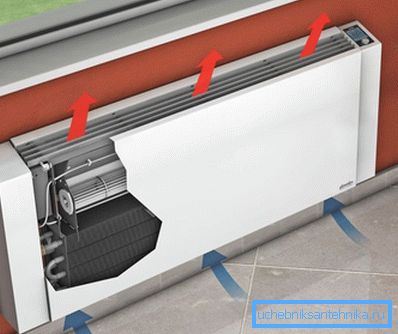Electric radiators of heating: main types and features of
In this article we will talk about what constitutes electric radiators and what is the instruction of their use. The topic of the article is of interest to owners of small country houses without the possibility of connecting to the gas distribution main.
In addition, such devices are universally purchased to control temperature parameters in small offices, at checkpoints, in small workshops, etc.

Main advantages and disadvantages

- The main advantages of the device include the possibility of intensive raising the temperature of the air in a closed room.. Moreover, most modifications of these devices are mobile. That is, the appliance, if necessary, can be disconnected from the network and transferred from one place to another.
- Among the shortcomings should be noted the high power consumption, and this is a considerable price of operation.. Another significant drawback of electric heaters are the increased demands on the quality and performance of power lines and the condition of household wiring. Thus, if the wiring in the house is old or the village electric grid is working in an overloaded condition, the operation of electric heaters will be impossible.
So, we have considered the main advantages and disadvantages of electric heaters, it remains to determine their varieties. (See also the article Floor heating convectors: features.)
Oil filled radiators

Oil-filled electric radiators are a category of low-temperature heaters. The devices operate on the principle of convective and radiation method of heat transfer. Most models of this type do not heat above +100 ° С.
As a heat carrier in these devices, a special oil is used, which is characterized by high thermal conductivity.
Important: It should be noted that oil-filled devices are the most economical in comparison with peers operating on a different principle.
Due to the relatively low degree of surface heating, these devices are the most secure. Using these electrical appliances is almost impossible to get burned by accidental touching.
Oil-filled heating radiators, in turn, are divided into the following categories:
- Sectional devices - in form similar to the traditional heating of steam or water heating. The device is based on an electric heating element. As a result of heating, the coolant circulates through the tubular body, which ensures uniform heating.
- Panel modification works on a similar principle with the difference that the external device looks like a rectangular panel without pronounced edges characteristic of radiators. Due to this feature, panel devices will perfectly fit into a modern interior.
- A separate type of oil-filled radiator is a mobile mobile version, which does not imply the need for installation. Devices of this type are convenient because they can be moved from one room to another during operation.
Important: Depending on the modification, these appliances have a power consumption ranging from 0.8 to 2.0 kW. Some versions are equipped with step-type thermostat, while others are equipped with stepless-type regulators.
Electric convector

Wall or floor convectors are another alternative to traditional heating radiators. The design of this heating device is a body made of steel or aluminum, inside which are located the heating elements. The degree of heating of the heater is controlled by a thermostat.
Heat element (TEH) is a conductor of high resistance, placed in a shell of ceramic. The heating element during heating transfers heat to the metal case, which, in turn, gives off heat to the external environment. In the upper part of the body there is a certain number of slots through which the main volume of heated air enters the room.
The advantage of convectors is the low temperature of heating of the casing not more than + 100 ° С, due to which the probability of air drying is completely excluded. Again, the device is completely safe, since you will not get burned by accidental contact.

The effectiveness of the use of convectors depends largely on the correctness of their location.
Strengthening the device under the window opening, we can achieve the following effect:
- The cold air goes down, while falling into the lower grille of the case;
- Passing through the heater, the cold air heats up and becomes easier;
- Releasing the warm air through the upper grate, it gives way to the newly arrived cold air, which rushes to the lower grate.
The process of air exchange will last smoothly until the heating element and the device case are completely cooled.
Infrared Reflectors

Electric infrared reflectors are an alternative to old spiral fireplaces, which consumed a lot of electricity and mercilessly dried the air. Modern wall reflectors do not have these disadvantages due to more efficient design and less intense heating of heating elements. (See also the article Biofuels for fireplaces: features.)
The principle of operation of these devices is not just to heat the heating element, but to convert electricity into an invisible spectrum of infrared waves. The infrared radiation of such heaters directly affects the surrounding surfaces, heating them. As a result, installing such an appliance on the wall, you turn the whole room into a large radiator.
Despite the fact that for a long time there have been discussions about the dangers of using such devices, today it has been proven that they are completely harmless to both the person himself and the heated room.
Conclusion
So, we have considered the main types of devices that can be used as heating radiators. After reviewing the description of these electrical appliances, you can choose the option that is most suitable for installation with your own hands in a particular room. More useful information you can find by watching the video in this article.